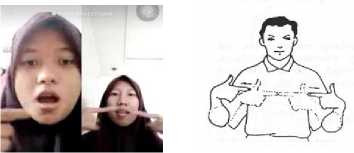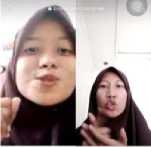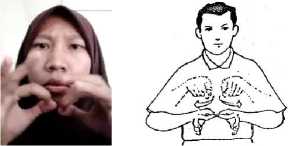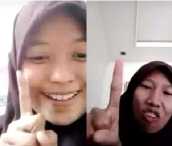Indonesian Sign Language System Analysis for Deaf Students at SLB Negeri 7 Jakarta During Pandemic
on
https://ojs.unud.ac.id/index.php/linguistika/
DOI: https://doi.org/10.24843/ling.2022.v29.i01.p08
LINGUISTIKA, MARET 2022
p-ISSN: 0854-9613 e-ISSN: 2656-6419
Vol. 29 No.1
Indonesian Sign Language System Analysis for Deaf Students at SLB Negeri 7 Jakarta During Pandemic
-
1,2, Harapan University, Medan, Indonesia e-mail: 1fadhilahramadhanty@gmail.com, 2zuindraidris@gmail.com
Abstract – This research aimed to determine the kinds and how sign language used by Deaf students in SLB Negeri 7 Jakarta, especially during the current Covid-19 pandemic. It was preceed as descriptive qualitative research which complied with observation and questionnaire method for data collection, continued by data analysis in accordance with Pierce’s Semiotics theory. The sample data was taken from the sign language produced by Deaf students at SLB Negeri 7 Jakarta. It was analyzed with SIBI Dictionary to find the prudeced sign meaning. This research resulted that SLB Negeri 7 Jakarta used SIBI as the main language on the learning activity and communicate between teachers and Deaf students.
Keywords: Sign Language; SIBI; Deaf Student
Abstrak – Penelitian ini bertujuan untuk mengetahui jenis dan bagaimana bahasa isyarat yang digunakan oleh siswa Tunarungu di SLB Negeri 7 Jakarta khususnya pada masa pandemic Covid-19 saat ini. Penelitian ini didahului dengan penelitian kualitatif deskriptif yang memenuhi metode observasi dan angket untuk pengumpulan data, dilanjutkan dengan analisis data sesuai dengan teori Semiotika Pierce. Data sampel diambil dari bahasa isyarat yang dihasilkan oleh siswa Tunarungu di SLB Negeri 7 Jakarta. Dianalisis menggunakan Kamus SIBI untuk menemukan makna tanda yang dihasilkan. Penelitian ini menghasilkan bahwa SLB Negeri 7 Jakarta menggunakan SIBI sebagai bahasa utama dalam kegiatan pembelajaran dan komunikasi antara guru dan siswa Tunarungu.
Kata Kunci: Bahasa Isyarat;SIBI; Siswa Tunarungu
Vol. 29 No.1
Humans are a social creature, who have a way of communicating, as well as the Deaf. The method used by the Deaf can be oral by reading lips, writing or sign language. As a means of communication, language has a very important role in community life. Communication is the transition of information, ideas, behaviors, or emotions form of sign that can be interpreted into words (Wibowo, 2009). The most effective communication for the Deaf used non-verbal communication. Nonverbal communication is a communication process where the way of delivery is using body language, facial expressions, or eye contact (Rofiandaru, 2005). This communication is often referred to as sign language
Sign language is a language that prioritizes manual communication through body language or lip movements. As mentioned by (Maulida, 2017) It usually combines the shape of hand, the orientation of the movement of the hands, arms, lips, or social interaction, one of the ways is by using sign language. In the daily activities of a Deaf person in social interaction, one of the ways is by using sign language. Therefore, the sign language used between the students and teacher at SLB Negeri 7 Jakarta is SIBI (Sistem Isyarat Bahasa Indonesia).
In learning sign language, students must be assisted by using learning media as teaching aids until students can understand the words. The use of learning media that is suitable for Deaf people is visual media that has clear picture and explains it by means of lip movements. Therefore, the sign language used between Deaf students and teachers at SLB Negeri 7 Jakarta is SIBI. The form of SIBI is a systematic arrangement of fingers, hands, and various movements that symbolized Indonesian vocabulary. This is one of the media that helps
communication as a teaching and learning aid for teachers in SLB Negeri 7 Jakarta. This sign language were correlated to the Semiotics which in the part of an Icon in Pierce Trichotomy theory as mentioned by (Pierce, n.d.).
Semiotics could be anywhere. The kinds of signs that are likely to show immediately to mind are those which we routinely refer to as ‘signs’ in everyday life, such as toad signs, building signs. (Chandler, 2007) also mentioned it also includes words, sounds, and body language. This can reinforce the theory that sign language is a form of body language and indicated to part of an Icon in Pierce theory.
Devitt & Hanley (2006) quoted from (Noermanzah, 2019) explains that language is a message conveyed in the form of an expression as a means of communication in certain situation in various activities. As stated by Chaer (2012) quoted from (Noermanzah, 2019) that language is also described in detail in the form of a system, in the form of symbols, in the form of sounds, arbitrart, meaningful, conventional, unique, universal, productive, varied, dynamic, humane, used a tool for social interaction, and funtions as an indentity of speaker. According to Chaer in (Rosdiana & Dkk, 2014) language is in the form of symbols, which means words or a combination of words in the language consisting of sound symbols, for example, the letter a-z in the alphabet. This proves that sign language which in the form of symbol can be used for a communication tool.
Vol. 29 No.1
Sign language is a language that focused on manual communication, body language, and lip movements. SIBI is the one of sign language used in Indonesia. SIBI formed in 1998 which stands for Sistem Isyarat Bahasa Indonesia. It is a language created bu the government to educate the nation through persons with disabilities, especially the Deaf.
SIBI has a word system closely same as Bahasa Indonesia word system, begun from the structures, prefix, suffix, rephrase, compound word, and the finger alphabet. In this sign system there is a supporting component such as performer, position, place, direction, frequency, facial expression, gestures, speed of movements, and flexibility. These components define a meaning of each sign.
This research conducted a descriptive qualitative method. Data analysis emphasized the quality and the results focused on forced of the object which will be parsed into a descriptive. This research was laid at SLB Negeri 7 Jakarta located in Jalan Kebon Manggis I, Matraman District, East Jakarta. This research only focused to the XIB Deaf Class student at the school. This school has many populations number of students.
Number of Students According to Type of Disability
|
SDLB |
SMPLB |
SMALB | |
|
Blind |
24 |
0 |
0 |
|
Deaf |
58 |
18 |
19 |
|
Intel. Disability |
76 |
43 |
41 |
|
Total |
158 |
61 |
60 |
The data collection techniques were observation and questionnaire. observation done by WhatsApp video call in English class. Because of
pandemic Covid-19, the observation could not lay at SLB Negeri 7 Jakarta directly. The questionnaire replaced a direct interview continued by distribute it to the informants.
The data analysis procedure was identified, classified, and made a conclusion. Identify was observed a several sources in the form of literature, read the data, and sorted the sign that identifies sign language. This procedure done by using video call via WhatsApp with the students. Classify was obtained the data in the form of screenshot pictures, which took the hand movements formed by the Deaf students and adjusted from the SIBI dictionary. Made a conclusion was chose the important data that described SIBI afterwards and results of the data drawn conclusion according to the evidence in the form of descriptive narratives.
This research used two methods of data collection, observation and questionnaire. The results will be desecribe below.
SLB Negeri 7 Jakarta used SIBI as a daily language conversation within Deaf students and the teachers in a school environment. During the Covid-19 pandemic, the school has been doing the distance learning or PJJ (Pembelajaran Jarak Jauh) instead of face-to-face learning. The teacjers prepared for the subject material and assignments for th students. The facilities that they used to fulfil the learning activities were WhatsApp group call and Zoom. Disability people also a moody type of person. This means their feeling situation was easy to change. Therefore, the most of informants said that was less of effectiveness. There were some methods to oncrease the effectiveness of learning activities during pandemic such as used the
Vol. 29 No.1
communication combination; verbal, sign language, and written and pictures if the students not really understand the material subject.
Discussed about the changes and resistances, it was actually the communication between teachers and Deaf students quite hard. Because, Deaf students cannot always know directly at that time, the teachers gave the explanations more. During the distance learning, an internet connection also became a resistance because of the communication tools and interent quota availabilities. Moving on to how to handle the challenges and resistances, by given more explanation and motivate were the main things. When the connection was lost, the subject material given by sending it directly to the students and asked the parents for help. In provide a motivation aimed to keep the students enthusiastic and cheerful in learning activities. In addition, provide an easy subject material also helped students quickly understand the lessons.
The methods of learning that the teacehrs did were the question and answer, theory or practice assignments, and interactions between teachers and students. These methods were the same between face-to-face and distance learning. The time sharing for distance learning was a half of a usual schedule while face-to-face learning. In this step, parent has an important role in a learning activity.
As mentioned above, a role of parents is important in a teaching and learning activities. By assisted parents, very helpful in facilitated the teaching and learning process and also helped the teacher while explain the materials. The teachers were very open to parents who want to ask questions about the material provided if they were not understood. Moreover, the teacher explained with a verbal explanation in order to easily
understood. But not all parents can be cooperated to work together to overcome their children in teaching and learning activities, this is also one of the challenges for the teacher.
One of the teachers said that knowledge in technology, especially with the recent existing techonological facilities is an important factor in increasing the effectiveness of teaching and learning activities that teachers can choose the right way for distance learning process. In all learning process, the sign language still being the main communication tool for the teachers and students.
There are two types of sign language used in Indonesia, such as SIBI (Sistem Isyarat Bahasa Indonesia) and BISINDO (Bahasa Isyarat Indonesia). This research only taken the SIBI, because SLB Negeri 7 Jakarta is using SIBI as a daily language conversation with Deaf students.
In this step, the analysis done by analyzing the picture which the sign language produced by the Deat students. Continued by match the picture of the students with the picture on the SIBI Dictionary to find the similarity, with this step, meaning could be found. Next step was classified each word and explained as same as on the SIBI Dictionary. The wrods that found are listed below.
-
a. Panjang – Long

Vol. 29 No.1
Figure 4.1
These pictures show the sign of “Long”. Which the right and left hands form the letter L face down horizontally facing the signer with the two tips of the index finger touching each other in front of the chest, straightened. (Kamus SIBI, 2001: 520)
-
b. Lagu – Song


Figure 4.2
These pictures show the sign of “Song”. Which the right hand forms the letter L horizontally pointing to the left, moved back and forth, and curved up front and back over the left hand which is supine pointing to the right in front of the chest. (Kamus SIBI, 2001: 388)
-
c. Sakit – Hurt

Figure 4.3
These pictures show the sign of “Hurt” of feeling hurts. Which the B right palm with thumb sticking out on the forehead. (Kamus SIBI, 2001: 626)
-
d. Heart – Heart


Figure 4.4
These pictures show the sign of “Heart”. Which the D right-hand with the index finger touching the left chest moved to form a heart sign. (Kamus SIBI, 2001: 274)
-
e. Cinta – Love

Figure 4.5
These pictures show the sign of “Love”. Which the right and left-hands are clenched into a fist, facing the signer, and crossed over the chest. (Kamus SIBI, 2001: 157)
-
f. Ibu – Mother

Figure 4.6
These pictures show the sign of “Mother”. Which the U right-hand fingertips that are upright facing forward, attached to the lower right earlobe. (Kamus SIBI, 2001: 290)

Figure 4.7
These pictures show the sign of “Meaning”. Which the fingers of the right-hand V pointing downwards facing the signer in the palm of the left-hand B which is supine pointing to the right
Vol. 29 No.1
hand in the front of chest, moving forward and back alternately. (Kamus SIBI, 2001: 45)
-
h. Pahlawan – Hero
forefinger sticking out, straighten on the right shoulder. (Kamus SIBI, 2001: 643)
-
k. Paham – Understand

Figure. 4.8


These pictures show the sign of “Hero”. Which the right and left hands of the faceted O are pointing forward in front of the chest, each is moved in a circle outward and back ending with a horizontal F facing forward with both thumbs rouching each other. (Kamus SIBI, 2001: 507)
Figure 4.11
These pictures show the sign of “Understand”. Which the right and left hands in 5 forms are upright facing forward at head level, rotated horizontally in opposite directions, then they are cupped with the fingertips against the forehead. (Kamus SIBI, 2001: 507)
-
l. Akan – Will
-
i. Indonesia

Figure 4.9
Figure


4.12
These pictures show the sign of “Indonesia”. Which right-hand His facing horizontally gesturing in front of the chest and moved to the right while shaking. (Kamus SIBI, 2001: 298)
-
j. Satu – One
These pictures show the sign of “Will”. Which the B’s right hand which is upright facing left at the side is moved curved upwards in front. (Kamus SIBI: 14)


m. Simple Present (S + Will + V1)

Figure 4.13
Figure 4.10
These pictures show the sign of “One”.
Which right hand with fingers clasped and
In addition to using a sign that represent a word, words that are not yet available in the SIBI dictionary, the Deaf communicate using the finger alphabet. This process is where a word is spelled
Vol. 29 No.1
letter by letter using the gesture finger alphabet. For example, as shown below.
As discussed in previous sections, there are two types of sign language used in Indonesia, SIBI and BISINDO. SIBI for formal used such as an institution, e.g., School. But, BISINDO likely more informal and used around Deaf communities out of institution. SIBI is the one of sign language used at SLB Negeri 7 Jakarta. It has become the main language between teachers and Deaf students during learning activity at school. Related to the current pandemic, several obstacles were found in a teaching and learning activities, especially in communicating. The limitations of existing communication with Deaf students, cupuled with long distance communication barriers, which require more efforts for the reachers to explained the materials to the students. In distance learning, the teachers, students, and parents were required to understand the latest technology to help the teaching and learning activity goes well. It has been found that not all of Indonesian language which was used in daily basis existed in SIBI Dictionary. Hence, the teachers and Deaf students use finger alphabet to overcome.
Chandler, D. (2007). Semiotics the
Basics, Second Edition -
69249454-chandler-semiotics.pdf. 29–30.
https://doi.org/10.1016/S0378-
2166(02)00176-5
Maulida, D. K. (2017). Bahasa isyarat indonesia di komunitas gerakan untuk kesejahteraan tunarungu indonesia. 1–2.
Noermanzah. (2019). Bahasa sebagai Alat Komunikasi, Citra Pikiran, dan Kepribadian. Prosiding
Seminar Nasional Bulan Bahasa (SEMIBA), 306–319.
Pierce, C. S. (n.d.). Semiotika #2.
Rofiandaru, M. (2005). Menggunakan Metode Komunikasi Total Untuk. https://core.ac.uk/download/pdf/3 5378171.pdf
Rosdiana, Y., & Dkk. (2014). Bahasa dan Sastra Indonesia di Sekolah Dasar. Bahasa Dan Sastra Indonesia Di Sekolah Dasar, 1,
1.6.
Wibowo, I. S. W. (2009). Semiotika, Aplikasi Praktis Bagi Penelitian dan Penulisan Skripsi Ilmu Komunikasi. 159.
64
Discussion and feedback